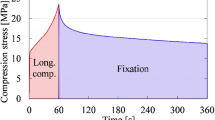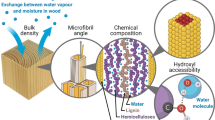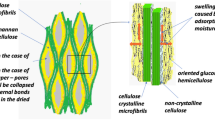Summary
The boundary desorption curve of the moisture content — water potential relationship of aspen sapwood was determined at 20 °C by the tension plate and pressure membrane methods for three specimen structural orientations and four imposed water potential values. The results show that the relationship is independent of the wood structural direction considered. Also, they further demonstrate that the discrepancies observed in a previous study between the moisture content — water potential relationships obtained with specimens of different structural orientations were due to a lack of equilibrium.
Similar content being viewed by others
References
Avramidis, S.; Kuroda, N.; Siau, J.F. 1987: Experiments in nonisothermal diffusion of moisture in wood. Part 2. Wood Sci. Technol. 19(4): 407–413
Barkas, W. W.; Hallan, R. 1953: A measurement of the forces of liquid retention by wet papermaking fibers. Proc. Tech. Sect. B. P. and B. M. A. 34: 289–310
Choong, E. T.; Tesoro, F. O. 1989: Relationship of capillary pressure and water saturation in wood. Wood Sci. Technol 23(2): 139–150
Cloutier, A.; Fortin, Y. 1991: Moisture content-water potential relationship of wood from saturated to dry conditions. Wood Sci. Technol. 23(2): 139–150
Cloutier, A.; Fortin, Y.; Dhatt, G. 1992: A wood drying finite element model based on the water potential concept. Drying Technology 10(5): 1151–1181
Cloutier, A.; Fortin, Y. 1993: A model of moisture movement in wood based on water potential and the determination of the effective water conductivity. Wood Sci. Technol. 27: 95–114
Fortin, Y. 1979: Moisture content-water potential relationship and water flow properties of wood at high moisture contents. Ph.D. dissertation, Dept. of Forestry, The University of British Columbia, Vancouver, Canada, 187 p.
Freund, R. J.; Littell, R. C. 1981: SAS for linear models. SAS Institute Inc. Cary, USA, 231 p.
Griffin, D. M. 1977: Water potential and wood decay fungi. Ann. Rev. Phytopathol. 15: 319–329
Hillel, D. 1971: Soil and water. Physical principles and processes. Academic Press, New York, London, 288 p.
Penner, E. 1963: Suction and its use as a measure of moisture contents and potentials in porous materials. In: Wexler, A. (Ed.): Humidity and moisture, Vol. 4 Reinhold Publ. Co., pp. 245–252. New York, USA
Perem, E. 1954: Determination of the fiber saturation point of wood by centrifuging. Forest Prod. J. 4(2): 77–81
Richards, L. A. 1941: A pressure-membrane extraction apparatus for soil solution. Soil Sci. 51: 377–386
Robertson, A. A. 1965: Investigation of the cellulose-water relationship by the pressure plate method. Tappi 48(10): 568–573
Siau, J. F. 1980: Nonisothermal moisture movement in wood. Wood Sci. 13(1): 11–13
Siau, J. F. 1992: Nonisothermal diffusion model based on irreversible thermodynamics. Wood Sci. Technol. 26(5): 325–328
Spolek, G. A.; Plumb, O. A. 1981: Capillary pressure in softwoods. Wood Sci. Technol. 15: 53–70
Stanish, M. A. 1986: The roles of bound water chemical potential and gas phase diffusion in moisture transport through wood. Wood Sci. Technol. 20(1): 53–70
Stone, J. E.; Scallan, A. M. 1967: The effect of component removal upon the porous structure of the cell wall of wood II. Swelling in water and the fiber saturation point. Tappi 50: 496–501
Viktorin, Z.; Cermak, B. 1977: Rozbor problematiky a urcovani chemickeho potencialu vlhkosti dreva. Drevarsky Vyskum 22: 235–259
Author information
Authors and Affiliations
Additional information
This research was supported by the Natural Sciences and Engineering Research Council of Canada through operating grant no. OGP0121954
Rights and permissions
About this article
Cite this article
Cloutier, A., Tremblay, C. & Fortin, Y. Effect of specimen structural orientation on the moisture content — water potential relationship of wood. Wood Sci.Technol. 29, 235–242 (1995). https://doi.org/10.1007/BF00202083
Received:
Issue Date:
DOI: https://doi.org/10.1007/BF00202083




